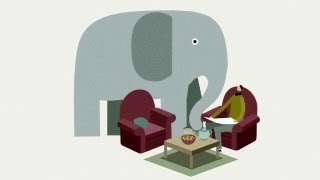(单词翻译:单击)
When we talk, sometimes we say things directly.
我们说话时,有时候会直接说。
"I'm going to the store.""I'll be back in 5 minutes."
“我要去商店。”“我5分钟内回来。”
Other times though, we talk in a way that conjures up a small scene.
有时,我们会换一种方式让人想象一个场景。
"It's raining cats and dogs out," we say, or "I was waiting for the other shoe to drop."
我们会说“外面正在下猫下狗,”(倾盆大雨)或“我在等另一只鞋扔下来。”(提心吊胆地等待最后结果)
Metaphors are a way to talk about one thing by describing something else.
隐喻就是通过描述别的东西来谈论一个事物。
That may seem roundabout, but it's not.
听起来像是绕圈子,但实际上不是。
Seeing and hearing and tasting are how we know anything first.
最初,我们通过看、听、尝来了解事物。
The philosopher William James described the world of newborn infants as a "buzzing and blooming confusion."
哲学家威廉·詹姆斯把新生儿的世界描述为:“嗡嗡作响的盛开的困惑”。
Abstract ideas are pale things compared to those first bees and blossoms.
抽象概念同最初的蜜蜂和花相比,十分苍白。
Metaphors think with the imagination and the senses.
隐喻同想象和感觉相联系。
The hot chile peppers in them explode in the mouth and the mind. They're also precise.
隐喻像辣椒,点燃了嘴巴和思想。它们还十分精确。
We don't really stop to think about a raindrop the size of an actual cat or dog,
我们不会停下来思考猫狗大小的雨滴,
but as soon as I do, I realize that I'm quite certain the dog has to be a small one
但是一旦思考的话,我就会明确知道狗一定很小
a cocker spaniel, or a dachshund -and not a golden lab or Newfoundland. I think a beagle might be about right.
也许是可卡犬或者腊肠,一定不会是拉布拉多或者纽芬兰犬。大概是小猎犬那么大。
A metaphor isn't true or untrue in any ordinary sense.
隐喻并不分真假。
Metaphors are art, not science, but they can still feel right or wrong.
隐喻是艺术,不是科学,但仍能分出对错。
A metaphor that isn't good leaves you confused.
不好的隐喻会让你困惑。
You know what it means to feel like a square wheel, but not what it's like to be tired as a whale.
你知道“觉得自己像一个方形轮”是什么意思,但不会明白“像蓝鲸一样累”。
There's a paradox to metaphors. They almost always say things that aren't true.
隐喻有一个悖论。他们总是用一些不真实的例子。
If you say, "there's an elephant in the room," there isn't an actual one, looking for the peanut dish on the table.
如果你说:“屋里有头大象。”(显而易见而又被忽略的事实),实际当然没有,看看桌上的花生就知道了。
Metaphors get under your skin by ghosting right past the logical mind.
隐喻从你的皮肤下直接连接逻辑思维。
Plus, we're used to thinking in images.
另外,我们习惯了形象思维。
Every night we dream impossible things. And when we wake up, that way of thinking's still in us.
每天晚上都梦到不可能发生的事。当我们醒来时,这种思维模式仍然存在。
We take off our dream shoes, and button ourselves into our lives.
我们离开梦境,一键进入现实生活。
Some metaphors include the words "like" or "as." "Sweet as honey," "strong as a tree." Those are called similes.
有些比喻里有“像”、“同”这样的字,“像蜂蜜一样甜”,“同树一样健壮”。这些是明喻。
A simile is a metaphor that admits it's making a comparison. Similes tend to make you think.
明喻运用了比较。明喻让你思考。
Metaphors let you feel things directly. Take Shakespeare's famous metaphor,
比喻让你直接感受事物。拿莎士比亚最著名的比喻来举例:
"All the world's a stage." "The world is like a stage" just seems thinner, and more boring.
“世界是一个舞台。”“世界像一个舞台。”看起来空洞,而且无趣。
Metaphors can also live in verbs.
动词中也存在比喻。
Emily Dickinson begins a poem, "I saw no way, the heavens were stitched,"
艾米莉·狄金森的诗以“我看不到路,天空已被缝合”开头,
and we know instantly what it would feel like if the sky were a fabric sewn shut.
我们马上就能明白天空变成一块织物是什么感觉。

They can live in adjectives too.
比喻也可以用在形容词上。
"Still waters run deep," we say of someone quiet and thoughtful.
“静水流深”用来指表面不声不响的人却蕴藏着大的智慧。
And the deep matters as much as the stillness and the water do.
像水流一样,深度和平静都十分重要。
One of the clearest places to find good metaphors is in poems.
诗歌是最容易出现好比喻的地方。
Take this haiku by the 18th century Japanese poet Issa. "On a branch floating downriver, a cricket singing."
以18世纪日本诗人小林一茶的俳句为例。“树枝顺流而下,蟋蟀在上面歌唱。”
The first way to meet a metaphor is just to see the world through its eyes:
发现比喻的的第一种方法,就是通过世界本身的眼睛看世界:
An insect sings from a branch passing by in the middle of the river.
树枝在河中央顺流而下,一只昆虫在上面歌唱。
Even as you see that though, some part of you recognizes in the image a small portrait of what it's like to live in this world of change and time,
即使你看到,部分你认出的画面,描绘了生活在由变化和时间构成的世界上是什么感觉
our human fate is to vanish, as surely as that small cricket will, and still, we do what it does. We live, we sing.
人终有一死,蟋蟀也一样即便如此,我们依旧活着,歌唱。
Sometimes a poem takes a metaphor and extends it, building on one idea in many ways.
有时,诗歌里有一个比喻并把它扩展,用不同的方法描绘一个构思。
Here's the beginning of Langston Hughes' famous poem "Mother to Son."
这是兰斯顿·休斯最著名的诗《母亲致儿子》的开头:
"Well, son, I'll tell you. Life for me ain't been no crystal stair.
“噢,儿子,我来告诉你:我的人生没有水晶般的阶梯。
It's had tacks in it, and splinters, and boards torn up, and places with no carpet on the floor."
那上面钉着钉子,有碎片,木板也是裂开的,地面没铺地毯--光秃秃的。”
Langston Hughes is making a metaphor that compares a hard life to a wrecked house you still have to live in.
兰斯顿·休斯将艰难的生活同不得已居住的年久失修的房子相比。
Those splinters and tacks feel real, they hurt your own feet and your own heart,
这些碎片和钉子十分真实,它们会划伤你的脚掌和内心,
but the mother is describing her life here, not her actual house.
但母亲是在描述自己的生活而不是房子。
And hunger, and cold exhausting work and poverty are what's also inside those splinters.
饥饿,寒冷令人疲惫的工作以及贫穷也在碎片之中。
Metaphors aren't always about our human lives and feelings.
比喻并不总是同人类生活和情感相关。
The Chicago poet Carl Sandburg wrote "The fog comes on little cat feet.
芝加哥诗人卡尔·桑德堡曾写道:“雾来了,轻轻地,踏着小猫的脚步。
It sits looking over harbor and city on silent haunches, and then moves on."
静静地,它坐下观看,观看城市和港口然后再重新上路。”
The comparison here is simple. Fog is being described as a cat.
这里的比喻十分简单。雾被形容成小猫。
But a good metaphor isn't a puzzle, or a way to convey hidden meanings, it's a way to let you feel and know something differently.
好的比喻不是猜谜,不用来传达隐藏的含义,而是让你从不同角度感受了解事物。
No one who's heard this poem forgets it.
听过这首诗的人都不会忘。
You see fog, and there's a small grey cat nearby.
你看见大雾,附近伴随着一只小灰猫。
Metaphors give words a way to go beyond their own meaning.
比喻让词语超越它们本来的意思。
They're handles on the door of what we can know, and of what we can imagine.
它们是门上的把手,是我们可以了解、想象的。
Each door leads to some new house, and some new world that only that one handle can open.
每扇门通向新的房子和新的世界,只有一个把手可以打开。
What's amazing is this: By making a handle, you can make a world.
最令人称奇的是这个:你可以通过造一个把手来制造一个世界。


